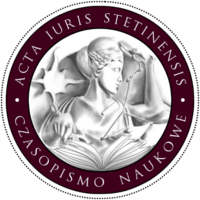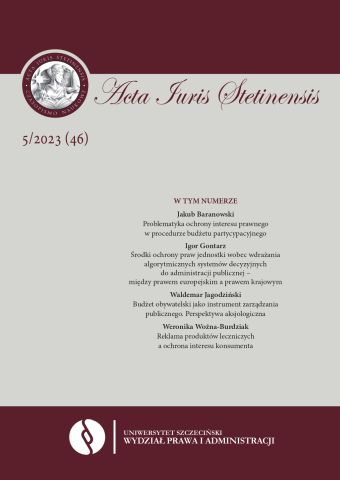






| Authors: |
Joanna
Bigos

Uniwersytet Wrocławski |
| Keywords: | legal interest based on organizational administrative law unit of local government “territorial” regulation asymmetry protection of legal interest |
| Page range: | 16 (21-36) |
| Downloads ?: | 58 |
| 1. | Adamiak B., Borkowski J., Postępowanie administracyjne i sądowo administracyjne, Wrocław 2015. |
| 2. | Bielecki L., Ruczkowski P. (red.), Ustrojowe prawo administracyjne, Warszawa 2011. |
| 3. | Bigo T., Związki publicznoprawne w świetle ustawodawstwa polskiego, Warszawa 1928. |
| 4. | Dolnicki B., Indywidualny akt normatywny, „Przegląd Prawa Publicznego” 2017, nr 6. |
| 5. | Dr K. Ziemski & Partners Kancelaria Prawna spółka komandytowa, Ekspertyza prawna w przedmiocie założeń nowelizacji przepisów ustawy o samorządzie gminnym dotyczących przeprowadzania zmian granic gmin, www.zgwrp.pl/attachments/article/1584/2019_11_04__3Konferencja%20Toru%C5%84_%20za%C5%82%20ekspertyza%20prawna%20-%20zmiana%20granic%20gmin.pdf. |
| 6. | Fundowicz S., Decentralizacja administracji publicznej w Polsce, Lublin 2005. |
| 7. | Izdebski H., Zmiany w zasadniczym podziale terytorialnym państwa. Wybrane aspekty prawne, „Samorząd Terytorialny” 2016, nr 7–8. |
| 8. | Jagoda J., Sądowa ochrona samodzielności jednostek samorządu terytorialnego, Warszawa 2011. |
| 9. | Lisowski P., Jednostki podziału terytorialnego w regulacjach ustawy o samorządzie powiatowym, w: J. Korczak (red.), Samorząd terytorialny III Rzeczypospolitej Polskiej. Materiały z konferencji z okazji 15-lecia samorządu terytorialnego w III Rzeczypospolitej Polskiej – Wrocław, 7–8 marca 2005 r., Wrocław 2005. |
| 10. | Lisowski P., Samorząd terytorialny a jednostka samorządu terytorialnego – rozważania semantyczne, w: J. Supernat (red.), Między tradycją a przyszłością w nauce prawa administracyjnego, Wrocław 2009. |
| 11. | Lisowski P., Ustrojowe qui pro quo – perspektywa podmiotowości w administracji samorządowej, w: M. Stec, K. Małysa-Sulińska (red.), Podmiotowość samorządu terytorialnego – ustrojowe pytania i dylematy, Warszawa 2020. |
| 12. | Mączyński M., Zmiana granic pomiędzy gminami: ocena rządowej polityki zmian w podziale terytorialnym pozostaje poza granicami oceny dokonywanej przez Trybunał Konstytucyjny, „Gdańskie Studia Prawnicze” 2020, nr 1 (45). |
| 13. | Niewiadomski Z., Teoretyczne podstawy samorządu, w tym samorządu terytorialnego, w: I. Lipowicz (red.), System prawa samorządu terytorialnego. Podstawowe pojęcia i podstawy prawne funkcjonowania, t. I, Warszawa 2022. |
| 14. | Niżnik-Dobosz I., Wprowadzenie, w: P. Chmielnicki (red.), Ustawa o samorządzie gminnym. Komentarz, Warszawa 2022. |
| 15. | Płażek S., Art. 24, w: P. Chmielnicki (red.), Ustawa o samorządzie gminnym. Komentarz, Warszawa 2022. |
| 16. | Szewczyk M., Szewczyk E., Generalny akt administracyjny, Warszawa 2014. |
| 17. | Tuleja P., Samorząd terytorialny jako sprawujący władzę publiczną, w: M. Stec, K. Małysa-Sulińska (red.), Konstytucyjne umocowanie samorządu terytorialnego, Warszawa 2020. |
| 18. | Wróbel A., Konstytucyjne podstawy samorządu terytorialnego – istota samorządu terytorialnego, zasady i pojęcia podstawowe, w: I. Lipowicz, System prawa samorządu terytorialnego. |
| 19. | Podstawowe pojęcia i podstawy prawne funkcjonowania, t. I, Warszawa 2022. |
| 20. | Wszołek P., O metodach badawczych stosowanych w nauce prawa administracyjnego dla poznawania prawa jako wypowiedzi normatywnej, „Przegląd Prawa Publicznego” 2011, nr 7–8. |